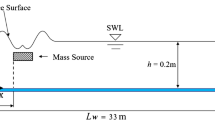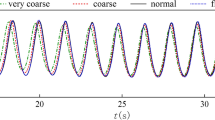Abstract
The semicircular breakwater (SBW) is a composite breakwater consisting of a hollow empty reinforced concrete caisson seated on the rubble mound breakwater. In this research, smoothed particle hydrodynamics (SPH) method was used to examine the run-up and overtopping of solitary waves on SBW. At first the SPH model was validated for regular wave–SBW interaction against experimental results. Comparisons showed that the present modified numerical model has a good agreement with experimental data. Parametric study was then performed on the effect of water depth and wave height of the single solitary waves and height of the rubble mound on wave run-up. Furthermore, double solitary waves were generated to study their interaction with SBW by the model. Run-up and reflection coefficient for double solitary wave–structure interaction was then investigated. The results show that in sum run-up in double solitary wave mode is smaller than that of single solitary wave. Moreover, the second solitary wave run-up is smaller than that of the first solitary wave in double solitary wave train. Overtopping discharge of double solitary wave is nearly constant for τ/T greater than 1.3, where τ/T is the ratio of time distance between wave crests of double wave to effective period of single solitary wave. Also overtopping discharge decreases with increasing in τ/T for its value smaller than 1.3. The results show that this model is a useful tool for simulating the interaction of solitary waves–structures with complicated geometry.


















Similar content being viewed by others
Reference
Qu K, Ren XY, Kraatz S (2017) Numerical investigation of tsunami-like wave hydrodynamic characteristics and its comparison with solitary wave. Appl Ocean Res 63:36–48. https://doi.org/10.1016/j.apor.2017.01.003
Romano A, Guerrini M, Bellotti G, Lie-hong J (2014) Laboratory generation of solitary waves: an inversion technique to improve available methods. China Ocean Eng 28:57–66. https://doi.org/10.1007/s13344-014-0004-9
Liu PL-F, Synolakis CE, Yeh H (1991) Report on the international workshop on long-wave run-up. J Fluid Mech 229:675–688. https://doi.org/10.1017/S0022112091003221
Synolakis CE, Bernard EN (2006) Tsunami science before and beyond boxing day 2004. Philos Trans R Soc A 364:2231–2265. https://doi.org/10.1098/rsta.2006.1824
Wu NJ, Tsay TK, Chen YY (2014) Generation of stable solitary waves by a piston-type wave maker. Wave Motion 51:240–255. https://doi.org/10.1016/j.wavemoti.2013.07.005
Wei Z, Dalrymple R, Herault A, Bilotta G, Rustico E, Yeh H (2015) SPH modeling of dynamic impact of tsunami bore on bridge piers. Coast Eng 104:26–42. https://doi.org/10.1016/j.coastaleng.2015.06.008
Di Risio M, De Girolamo P, Bellotti G, Panizzo A, Aristodemo F, Molfetta MG, Petrillo AF (2009) Landslide-generated tsunamis runup at the coast of a conical island: new physical model experiments. J Geophys Res-Oceans 114(C1):1–16. https://doi.org/10.1029/2008JC004858
Sasajima H, Koizuka T, Sasayama H (1994) Field demonstration test of a semicircular breakwater. In: Proceedings of HYDROPORT 94 Yokosuka Japan, vol 1, pp 593–610
Goda Y (1974) A new method of wave pressure calculations for the design of composite breakwaters. In: Proceedings of the 14th International Conference in Coastal Engineering, Copenhagen, pp 1702–1720
Sundar V, Raghu D (1997) Wave induced pressures on semicircular breakwater. In: Proceedings of 2nd Indian National Conference on Harbour and Ocean Engineering, Thiruvananthapuram, pp 278–287
Sundar V, Raghu D (1998) Dynamic pressures and run-up on semicircular breakwater due to random waves. Ocean Eng 25:221–241. https://doi.org/10.1016/S0029-8018(97)00007-3
Sri Krishna Priya M, Roopsekhar KA, Sundar V, Sundaravadivelu R, Graw KU, Kna S (2000) Hydrodynamic pressures on semicircular breakwaters. In: Proceedings of International Conference on Hydroscience and Engineering, Seoul, South korea
Yuan D, Tao J (2003) Wave forces on submerged, alternately submerged, and emerged semicircular breakwaters. Coast Eng 48:75–93. https://doi.org/10.1016/S0378-3839(02)00169-2
Dhinakaran G, Sundar V, Sundaravadivelu R, Graw KU (2008) Effect of perforations and rubble mound height on wave transformation characteristics of surface piercing semicircular breakwaters. Ocean Eng 36:1182–1198. https://doi.org/10.1016/j.oceaneng.2009.08.005
Shi YJ, Wu ML, Jiang XL, Li YB (2011) Experimental researches on reflective and transmitting performances of quarter circular breakwater under regular and irregular waves. China Ocean Eng 25(3):469–478
Kasem TH, Sasaki J (2010) Multiphase modeling of wave propagation over submerged obstacles using weno and level set methods. Coast Eng J 52(3):235–259. https://doi.org/10.1142/S0578563410002166
Hafeeda V, Binumol S, Hegde AV, Subbarao (2014) Wave reflection by emerged seaside perforated quarter-circle breakwater. Int J Earth Sci Eng 7(2):454–460
Shao S (2005) SPH simulation of solitary wave interaction with a curtain-type breakwater. J Hydraul Res 43(4):366–375. https://doi.org/10.1080/00221680509500132
Ketabdari MJ, Kamani N, Moghaddam MH (2015) WCSPH simulation of solitary wave interaction with a curtain-type breakwater. In: AIP Conference Proceedings, AIP Publishing. https://doi.org/10.1063/1.4912976
Rostami Varnousfaaderani M, Ketabdari MJ (2015) Numerical simulation of solitary wave breaking and impact on seawall using a modified turbulence SPH method with Riemann solvers. J Mar Sci Technol 20(2):344–356. https://doi.org/10.1007/s00773-014-0287-9
Akbari H (2017) Simulation of wave overtopping using an improved SPH method. Coast Eng 126:51–68. https://doi.org/10.1016/j.coastaleng.2017.04.010
Paprota M, Staroszczyk R, Sulisz W (2017) Eulerian and Lagrangian modelling of a solitary wave attack on a seawall. J Hydro-Environ Res. https://doi.org/10.1016/j.jher.2017.09.001
Liang D, Jian W, Shao S, Chen R, Yang K (2017) Incompressible SPH simulation of solitary wave interaction with movable seawalls. J Fluids Struct 69:72–88. https://doi.org/10.1016/j.jfluidstructs.2016.11.015
Aristodemo F, Tripepi G, Meringolo DD, Veltri P (2017) Solitary wave-induced forces on horizontal circular cylinders: laboratory experiments and SPH simulations. Coast Eng 129:17–35. https://doi.org/10.1016/j.coastaleng.2017.08.011
Lo EYM, Shao S (2002) Simulation of near-shore solitary wave mechanics by an incompressible SPH method. Appl Ocean Res 24:275–286
Nam HK, Haeng SK (2008) Numerical simulation on solitary wave propagation and run-up by SPH method. KSCE J Civil Eng 12(4):221–226. https://doi.org/10.1007/s12205-008-0221-y
Memarzadeh R, Hejazi K (2012) ISPH numerical modeling of nonlinear wave run-up on steep slopes. J Persian Gulf 3(10):17–26
Gingold RA, Monaghan JJ (1977) Smoothed particle hydrodynamics: theory and allocation to non-spherical stars. R Astron Soc Mon Not 181:375–389. https://doi.org/10.1093/mnras/181.3.375
Monaghan JJ (1992) Smoothed particle hydrodynamics. Annu Rev Astron Astrophys 30:543–574. https://doi.org/10.1146/annurev.aa.30.090192.002551
Monaghan JJ (1994) Simulating free surface flows with SPH. J Comput Phys 110:399–406. https://doi.org/10.1006/jcph.1994.1034
Rogers BD, Dalrymple RA (2004) SPH modeling of breaking waves. In: Proceedings of the 14th International Conference in Coastal Engineering, World Scientific Press, pp 415–427
Monaghan JJ (1989) On the problem of penetration in particle methods. J Comput Phys 82:1–15. https://doi.org/10.1016/0021-9991(89)90032-6
Monaghan JJ, Kos A (1999) Solitary waves on a Cretan beach. J Waterw Port Coast Ocean Eng 125(3):145–154. https://doi.org/10.1061/(ASCE)0733-950X
Gómez-Gesteira M, Crespo AJC, Rogers BD, Dalrymple RA, Domínguez JM (2012) SPHysics-development of a free-surface fluid solver-Part 1: theory and formulations. Comput Geosci 48:289–299. https://doi.org/10.1016/j.cageo.2012.02.029
Gómez-Gesteira M, Rogers BD, Crespo AJC, Dalrymple RA, Domínguez JM, Barreiro A (2012) SPHysics-development of a freesurface fluid solver-Part 2: efficiency and test cases. Comput Geosci 48:300–307. https://doi.org/10.1016/j.cageo.2012.02.028
Katell G, Eric B (2002) Accuracy of solitary wave generation by a piston wave maker. J Hydraul Res 40(3):321–331. https://doi.org/10.1080/00221680209499946
Lo HY, Park YS, Liu PLF (2013) On the run-up and back-wash processes of single and double solitary waves–an experimental study. Coast Eng 80:1–14. https://doi.org/10.1016/j.coastaleng.2013.05.001
Grue J, Pelinovsky EN, Fructus D, Talipova T, Kharif C (2008) Formation of undular bores and solitary waves in the Strait of Malacca caused by the 26 December 2004 Indian Ocean tsunami. J Geophys Res 113:C05008. https://doi.org/10.1029/2007JC004343
Madsen PA, Fuhrman DR, Schaffer HA (2008) On the solitary wave paradigm for tsunamis. J Geophys Res 113:C12012. https://doi.org/10.1029/2008JC004932
Dong J, Wang BL, Liu H (2015) Run-up of non-breaking double solitary waves with equal wave heights on a plane beach. J Hydrodyn 26(6):939–950. https://doi.org/10.1016/S1001-6058(14)60103-7
Ketabdari MJ, Sepyani H (2010) Wave generation with flap type wave maker by SPH method. In: 12th Marine Industry Conferences, Zibakenar, Iran
Meringolo DD, Aristodemo F, Veltri P (2015) SPH numerical modeling of wave–perforated breakwater interaction. Coast Eng 101:48–68. https://doi.org/10.1016/j.coastaleng.2015.04.004
Galvin CJ, Eagleson PS (1964) Experimental study of longshore currents on a plane beach. Massachusetts Institute of Technology, Hydrodynamics Laboratory, Cambridge
Dean RG, Dalrymple RA (1991) Water wave mechanics for engineering and scientists. World Scientific Press, Singapore
Goda Y, Suzuki Y (1976) Estimation of incident and reflected wave in regular wave experiment. In: Proceedings of 15th Coastal Engineering Conference, pp 828–845
Author information
Authors and Affiliations
Corresponding author
Additional information
Technical Editor: Celso Kazuyuki Morooka.
Rights and permissions
About this article
Cite this article
Fathi, A., Ketabdari, M.J. Modeling of emerged semi-circular breakwater performance against solitary waves using SPH method. J Braz. Soc. Mech. Sci. Eng. 40, 290 (2018). https://doi.org/10.1007/s40430-018-1179-4
Received:
Accepted:
Published:
DOI: https://doi.org/10.1007/s40430-018-1179-4




